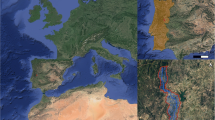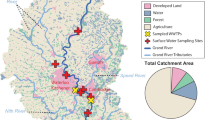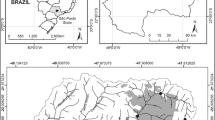Abstract
Drought conditions should magnify the effect of wastewater treatment plant (WWTP) effluent on river biogeochemistry. This study examined the impact of WWTP effluent on the Enoree River in the piedmont region of South Carolina during a period of significant drought. The Enoree River lacks impoundments, upstream agricultural runoff, and significant industrial point sources, so the single most important human influence on river chemistry is WWTP effluent. Water samples were collected from 28 locations on the Enoree River, 13 of its tributaries, and the effluent of four WWTPs. Effluent from the WWTP furthest upstream increased the salinity of the river and temporal variation and concentrations of most ions, especially nitrate, phosphate, sulfate, sodium, and chloride. The upstream WWTP set the downstream chemical composition of the river, with increasing proportions of chloride, sodium, and sulfate and decreasing proportions of dissolved silicon and bicarbonate. Downstream WWTPs had little or no impact on the chemical composition of the river. Mixing model results show that dilution was the dominant process of the downstream decrease in solute concentrations, but in-channel uptake mechanisms also contributed to declines in concentrations of nitrate, phosphate, and carbon dioxide. Despite dilution and uptake, the chemical signature of WWTP effluent was still evident 135 km downstream. These results lead to a better understanding of the effects of WWTP effluent on the biogeochemistry of rivers.









Similar content being viewed by others
References
Admiraal, W., Breugem, P., Jacobs, D. M. L. H. A., & de Ruyter Van Steveninck, E. D. (1990). Fixation of dissolved silicate and sedimentation of biogenic silicate in the lower river Rhine during diatom blooms. Biogeochemistry, 9, 175–185.
Andersen, C. B. (2001). The problem of sample contamination in a fluvial geochemistry research experience for undergraduates. Journal of Geoscience Education, 49, 351–357.
Andersen, C. B. (2002). Understanding carbonate equilibria by measuring alkalinity in experimental and natural systems. Journal of Geoscience Education, 50, 389–403.
Andersen, C. B., Sargent, K. A., Wheeler, J. F., & Wheeler, S. K. (2001). Fluvial geochemistry of selected tributary watersheds in the Enoree River Basin, northwestern South Carolina. South Carolina Geology, 43, 57–71.
Andersen, C. B., Lewis, G. P., & Sargent, K. A. (2004). Influence of wastewater treatment effluent on concentrations and fluxes of solutes in the Bush River, South Carolina, during extreme drought conditions. Environmental Geosciences, 11, 28–41.
Aufdenkampe, A. K., Mayorga, E., Raymond, P. A., Melack, J. M., Doney, S. C., Simone, R., et al. (2011). Riverine coupling of biogeochemical cycles between land, oceans, and atmosphere. Frontiers in Ecology and the Environment, 9, 53–60.
Berner, E. K., & Berner, R. A. (1996). Global environment: Water, air, and geochemical cycles. Upper Saddle River: Prentice-Hall.
Bowes, M. J., Smith, J. T., Neal, C., Leach, D. V., Scarlett, P. M., Wickham, H. D., et al. (2011). Changes in water quality of the River Frome (UK) from 1965 to 2009: Is phosphorus mitigation finally working? Science of the Total Environment, 409, 3418–3430.
Butler, J. R., & Secor, D. T., Jr. (1991). The Central Piedmont. In J. W. Horton Jr. & V. A. Zullo (Eds.), The geology of the Carolinas (pp. 59–78). Knoxville: The University of Tennessee Press.
Camp, W. (1975). Soil survey of Greenville County, SC. Washington, D.C.: United States Department of Agriculture Soil Conservation Service.
Carey, R. O., & Migliaccio, K. W. (2009). Contribution of wastewater treatment plant effluents to nutrient dynamics in aquatic systems: A review. Environmental Management, 44, 205–217.
Cole, J. J., Prairie, Y. T., Caraco, N. F., McDowell, W. H., Tranvik, L. J., Striegl, R. G., et al. (2007). Plumbing the global carbon cycle: Integrating inland waters into the terrestrial carbon budget. Ecosystems, 10, 171–184.
Correll, D. L., Jordan, T. E., & Weller, D. E. (2000). Beaver pond biogeochemical effects in the Maryland coastal plain. Biogeochemistry, 49, 217–239.
Dynesius, M., & Nilsson, C. (1994). Fragmentation and flow regulation of river systems in the northern third of the world. Science, 266, 753–762.
Flintrop, C., Hohlmann, B., Jasper, T., Korte, C., Podlaha, O. G., Scheele, S., et al. (1996). Anatomy of pollution: Rivers of North Rhine-Westphalia, Germany. American Journal of Science, 296, 58–98.
Forshay, K. J., & Stanley, E. H. (2005). Rapid nitrate loss and denitrification in a temperate river floodplain. Biogeochemistry, 75, 43–64.
Freeze, R. A., & Cherry, J. A. (1979). Groundwater. Englewood: Prentice-Hall.
Froelich, P. N. (1988). Kinetic control of dissolved phosphate in natural rivers and estuaries: A primer on the phosphate buffer mechanism. Limnology and Oceanography, 33, 649–668.
Goherman, H. L., & Meyer, M. L. (1985). The geochemistry of two hard water rivers: The Rhine and the Rhone. Part 2: The apparent solubility of calcium carbonate. Hydrobiologia, 126, 11–19.
Goolsby, D. A. (2000). Mississippi basin nitrogen flux believed to cause Gulf hypoxia. Eos, 81, 321–327.
Green, M., Arroyo, K., Lewis, G. P., Andersen, C. B., & Wheeler, S. (2005). Natural attenuation of nutrients by wetlands in the Bush River, South Carolina. Geological Society of America Abstracts With Programs, 37, 44.
Grimaldi, C., & Chaplot, V. (2000). Nitrate depletion during within-stream transport: Effects of exchange processes between streamwater, the hyporheic and riparian zones. Water, Air, and Soil Pollution, 124, 95–112.
Haggard, B. E., Stanley, E. H., & Storm, D. E. (2005). Nutrient retention in a point-source-enriched stream. Journal of the North American Benthological Society, 24, 29–47.
Hall, R. O., Jr. (2003). A stream's role in watershed nutrient export. Proceedings of the National Academy of Sciences, 100, 10137–10138.
Hill, A. R., Labadia, C. F., & Sanmugadas, K. (1998). Hyporheic zone hydrology and nitrogen dynamics in relation to the streambed topography of a N-rich stream. Biogeochemistry, 42, 285–310.
Hinkle, S. R., Duff, J. H., Triska, F. J., Laenen, A., Gates, E. B., Bencala, K. E., et al. (2001). Linking hyporheic flow and nitrogen cycling near the Willamette River—a large river in Oregon, USA. Journal of Hydrology, 244, 157–180.
Horton, J. W., Jr., & McConnell, K. I. (1991). The Western Piedmont. In J. W. Horton Jr. & V. A. Zullo (Eds.), The geology of the Carolinas (pp. 79–92). Knoxville: The University of Tennessee Press.
Howarth, R. W., Billen, G., Swaney, D., Townsend, A., Jaworski, N., Lajtha, K., et al. (1996). Regional nitrogen budgets and riverine N & P fluxes for the drainages to the North Atlantic Ocean: Natural and human influences. Biogeochemistry, 35, 75–139.
Huh, Y., Tsoi, M.-Y., Zaitsev, A., & Edmond, J. M. (1998). The fluvial geochemistry of the rivers of Eastern Siberia: I. Tributaries of the Lena River draining the sedimentary platform of the Siberian Craton. Geochimica et Cosmochimica Acta, 62, 1657–1676.
Humborg, C., Conley, D. J., Rahm, L., Wulff, F., Cociasu, A., & Ittekkot, V. (2000). Silicon retention in river basins: Far-reaching effects of biogeochemistry and aquatic food webs in coastal marine environments. Ambio, 29, 45–50.
Humborg, C., Blomqvist, S., Avsan, E., Bergensund, Y., Smedberg, E., Brink, J., et al. (2002). Hydrological alterations with river damming in northern Sweden: Implications for weathering and river biogeochemistry. Global Biogeochemical Cycles, 16, 12-1–12-13.
Jarvie, H. P., Sharpley, A. N., Scott, J. T., Haggard, B. E., Bowes, M. J., & Massey, L. B. (2012). Within-river phosphorus retention: Accounting for a missing piece in the watershed phosphorus puzzle. Environmental Science and Technology, 46, 13284–13292.
Johnson, G. C., & Treece, M. W. (1998). Phosphorus in streams in the Upper Tennessee Basin, 1970–1993. U.S.G.S. Open-Files Report, 98–532, 1–6.
Johnston, C. A., Bridgham, S. D., & Schubauer-Berigan, J. P. (2001). Nutrient dynamics in relation to geomorphology of riverine wetlands. Soil Science Society of America Journal, 65, 557–577.
Kim, J. P., Reid, M. R., Cunninghame, R. G., & Hunter, K. A. (1996). Aqueous chemistry of major ions and trace metals in the Clutha River, New Zealand. Marine & Freshwater Research, 47, 918–929.
Lewis, G. P., Mitchell, J., Andersen, C. B., Haney, D., Liao, M. K., & Sargent, K. A. (2007). Urban influences on stream chemistry and biology in the Big Brushy Creek watershed, South Carolina. Water, Air, and Soil Pollution, 182, 303–323.
Marti, E., Aumatell, J., Godé, L., Poch, M., & Sabater, F. (2004). Nutrient retention efficiency in streams receiving inputs from wastewater treatment plants. Journal of Environmental Quality, 33, 285–293.
Meybeck, M. (1980). Pathways of major elements from land to ocean through rivers. In J. M. Martin, J. D. Burton, & D. Eisma (Eds.), Proceedings of the Review and Workshop on River Inputs to Ocean Systems (pp. 18–30). Rome: FAO.
Meybeck, M. (1998). Man and river interface: Multiple impacts on water and particulates chemistry illustrated in the Seine River basin. Hydrobiologia, 373/374, 1–20.
Moreau, S., Bertru, G., & Buson, C. (1998). Seasonal and spatial trends of nitrogen and phosphorous loads to the upper catchment of the river Vilaine (Brittany): Relationships with land use. Hydrobiologia, 373/374, 247–258.
Muthukrishnan, S., Lewis, G. P., & Andersen, C. B. (2007). Chapter 24. Relations among land cover, vegetation index, and nitrate concentrations in streams of the Enoree River Basin, piedmont region of South Carolina, USA. In D. Sarkar, R. Datta, & R. Hannigan (Eds.), Concepts and applications in environmental geochemistry (pp. 515–539). New York: Elsevier.
National Weather Service (2007) Detailed climate information for Greenville-Spartanburg Airport. Retrieved December 14, 2007, from http://www.erh.noaa.gov/gsp/climate/gsppcp.htm. Accessed December 2007.
Neal, C., House, A. W., Jarvie, H. P., & Eatherall, A. (1998). The significance of dissolved carbon dioxide in major lowland rivers entering the North Sea. Science of the Total Environment, 210(211), 187–203.
Neal, C., Jarvie, H. P., Neal, M., Love, A. J., Hill, L., & Wickham, H. (2005). Water quality of treated sewage effluent in a rural area of the upper Thames basin, southern England, and the impacts of such effluents on riverine phosphorus concentrations. Journal of Hydrology, 304, 103–117.
Neal, C., Neal, M., Hill, L., & Wickham, H. (2006). The water quality of the River Thames in the Thames Basin of south/south-eastern England. Science of the Total Environment, 360, 254–271.
Palmer-Felgate, E. J., Jarvie, H. P., Williams, R. J., Mortimer, R. J. G., Loewenthal, M., & Neal, C. (2008). Phosphorus dynamics and productivity in a sewage-impacted lowland chalk stream. Journal of Hydrology, 351, 87–97.
Paul, M. J., & Meyer, J. L. (2001). Streams in the urban landscape. Annual Reviews of Ecology and Systematics, 32, 333–365.
Peterson, B. J., Wollheim, W. M., Mulholland, P. J., Webster, J. R., Meyer, J. L., Tank, J. L., et al. (2001). Control of nitrogen export from watersheds by headwater streams. Science, 292, 86–90.
Piñol, J., & Avila, A. (1992). Streamwater pH, alkalinity, pCO2 and discharge relationships in some forested Mediterranean catchments. Journal of Hydrology, 131, 205–225.
Plummer, L. N., & Busenbeck, E. (1982). The solubilities of calcite, aragonite and vaterite in CO2–H2O solutions between 0–90 °C, and an evaluation of the aqueous model for the system CaCO3–CO2–H2O. Geochimica Cosmochimica Acta, 46, 1011–1040.
Raymond, P. A., Oh, N.-H., Turner, R. E., & Broussard, W. (2008). Anthropogenically enhanced fluxes of water and carbon in the Mississippi River. Nature, 451, 449–452.
Reddy, K. R., Kadlec, R. H., & Flaig, E. (1999). Phosphorus retention in streams and wetlands: A review. Critical Reviews in Environmental Science and Technology, 29, 83–146.
Roy, S., Gaillardet, J., & Allegre, C. J. (1999). Geochemistry of dissolved and suspended loads of the Seine River, France: Anthropogenic impact, carbonate and silicate weathering. Geochimica et Cosmochimica Acta, 63, 1277–1292.
Saunders, D. L., & Kalff, J. (2001). Nitrogen retention in wetlands, lakes, and rivers. Hydrobiologia, 443, 205–2112.
Scott, S., Andersen, C. B., Sargent, K. A., Lewis, G. P., & Wheeler, S. (2004). The chemical composition of wastewater treatment plant effluent in Upstate South Carolina. Geological Society of America Abstracts with Programs, 36, 125.
Seitzinger, S. P., Styles, R. V., Boyer, E. W., Alexander, R. B., Billen, G., Howarth, R. W., et al. (2002). Nitrogen retention in rivers: Model development and application to watersheds in the northeastern U.S.A. Biogeochemistry, 57(58), 199–237.
South Carolina Department of Health and Environmental Control (SCDHEC). (2001). Water quality assessment: Broad River Basin. Technical Report 001-01. Columbia: Bureau of Water.
Stallard, R. F., & Edmond, J. M. (1983). Geochemistry of the Amazon 2. The influence of geology and weathering environment on the dissolved load. Journal of Geophysical Research C, 88, 9671–9688.
Strahler, A. N. (1952). Dynamic basis of geomorphology. Geological Society of America Bulletin, 63, 923–938.
Stutter, M. I., Demars, B. O. L., & Langan, S. J. (2010). River phosphorus cycling: Separating biotic and abiotic uptake during short-term changes in sewage effluent loading. Water Research, 44, 4425–4436.
Thibert, S. (1984). Exportations naturelles et anthropiques des ions majeurs et des elements nutritifs dans la basin de la Seine. Ph.D. thesis, University of Paris 6, France.
Triska, F. J., Kennedy, V. C., Avanzino, R. J., Zellweger, G. W., & Bencala, K. E. (1989). Retention and transport of nutrients in a third-order stream: Channel processes. Ecology, 70, 1877–1892.
United States Geological Survey (USGS) (2004). National Water Information System. Retrieved February 15 2004 from http://waterdata.usgs.gov/nwis/. Accessed February 2004.
United States Geological Survey (USGS) (2014). USGS 02160325 Brushy Creek Near Greenville, SC. Retrieved March 1 2014 from http://waterdata.usgs.gov/nwis/uv?02160325. Accessed March 2014.
Venterink, H. O., Wiegman, F., Van der Lee, G. E. M., & Vermaat, J. E. (2003). Role of active floodplains for nutrient retention in the River Rhine. Journal of Environmental Quality, 32, 1430–1435.
Verbanck, M., Vanderborght, J.-P., & Wollast, R. (1989). Major ion content of urban wastewater: Assessment of per capita loading. Research Journal of the Water Pollution Control Federation, 61, 1722–1728.
Vörösmarty, C. J., Sharma, K. P., Fekete, B. M., Copeland, A. H., Holden, J., Marble, J., et al. (1997). The storage and aging of continental runoff in large reservoir systems of the world. Ambio, 26, 210–219.
Whitmire, S. L., & Hamilton, S. K. (2005). Rapid removal of nitrate and sulfate in freshwater wetland sediments. Journal of Environmental Quality, 34, 2062–2071.
Withers, P. J. A., & Jarvie, H. P. (2008). Delivery and cycling of phosphorus in rivers: A review. Science of the Total Environment, 400, 379–395.
Zhiliang, S., Qun, L., Shumel, Z., Hui, M., & Ping, Z. (2003). A nitrogen budget of the Changjiang River catchment. Ambio, 32, 65–69.
Zhu, Z., Deng, Q., Zhou, H., Ouyang, T., Kuang, Y., Huang, N., et al. (2002). Water pollution and degradation in Pearl River Delta, South China. Ambio, 31, 226–257.
Acknowledgement
We thank the two anonymous reviewers that provided comments that substantially improved this paper. We thank the members of the 1999 and 2000 River Basin Research Initiative Research Experiences for Undergraduates (REU) program for the help with collecting and analyzing samples. We also thank John and Sandy Wheeler of the Department of Chemistry at Furman University for helping with ion chromatography and ICP-AES analyses. Suresh Muthukrishnan of the Department of Earth and Environmental Sciences Department at Furman provided the location map. The South Carolina Department of Health and Environmental Control provided data regarding WWTP effluent discharge. Western Carolina Sewer Authority (now Renewable Water Resources) generously allowed us to collect samples of WWTP effluent. This study was funded by NSF-REU grant #EAR-9820605, South Carolina DHEC NPS Program grant #EQ-9-461, a grant from the Associated Colleges of the South, and Furman University.
Author information
Authors and Affiliations
Corresponding author
Rights and permissions
About this article
Cite this article
Andersen, C.B., Lewis, G.P., Hart, M. et al. The Impact of Wastewater Treatment Effluent on the Biogeochemistry of the Enoree River, South Carolina, During Drought Conditions. Water Air Soil Pollut 225, 1955 (2014). https://doi.org/10.1007/s11270-014-1955-4
Received:
Accepted:
Published:
DOI: https://doi.org/10.1007/s11270-014-1955-4




